
Features
Training
Opening doors; Airbags, rollover protection challenge rescuers
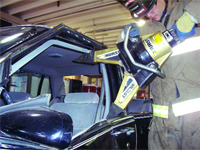 |
| Rescuers should open the spreading tool significantly to create the largest possible opening to enhance access to the lower hinge. PHOTOS BY PETE METHNER |
Preparation
There are things to consider before starting an extrication that may affect the removal of the patient from the entrapment. We will assume that the scene and vehicle have been stabilized, that fire or EMS has made patient contact and the patient(s) have been protected.
Often we may see EMS personnel make easy access to the patient from the opposite side of the vehicle through an undamaged door or window. From this awkward position, we may see rescuers muscle a patient over the centre console to get the patient out of the wreckage. With today’s tool technology and the training that firefighters obtain and continually practise, there is no reason to handle any patient this way. We must always consider the potential long-term injuries and recovery time of the patient(s).
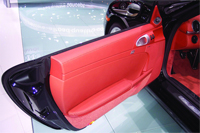 |
| Vehicle airbag identification that identifies the door ROPS bag location. |
The Porsche Boxster has a new airbag (2006) that is located in the door and it deploys upward on the inside of the door window to protect the patient during a rollover. This is referred to as the roll-over protection system (ROPS). If you face this vehicle you will have ROPS protection from the door as well as thorax protection from a bag that will deploy from the outboard side of the seat.
Important purchase-point consideration
It’s important to know that the inflation cylinder for the ROPS in this Boxster is located in the interior, top portion of the door near the door handle. This is the only vehicle with this type of ROPS to date and the only vehicle with an inflation cylinder in the door.
Departments that may squeeze a door with the spreaders to gain a purchase point must avoid this technique on the Porsche Boxster to prevent compressing the pressurized inflation cylinder.
This said, rescuers should look at the external impact damage of the door. The deformation of metal will tell you its own story. It may tell you where the side impact beam is located beneath the outer door skin. It may also expose the upper and lower hinge location as well. Purchase points should naturally present themselves.
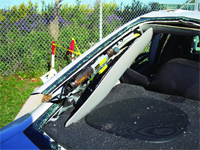 |
| Cutaway shows location of airbag cylinder. |
Rescuers must consider the patient location prior to extrication and determine if they are going to open the door at the latch mechanism first or the hinge side first. If the patient is sitting in the upright position and a rescuer has C-spine immobilization in place, then you may want to remove the door at the hinge location first.
Door removal
Once rescuers have scanned the interior for airbags they should then strip the trim to remove any interior trim that may cover an inflator for the airbag system (rescuers want to avoid inflation cylinders, not only when cutting but also when spreading – a spreader’s tip could inadvertently and dangerously press against the pressurized inflation cylinder).
If rescuers have determined that there isn’t an inflation cylinder present (in the “A” pillar), they can place the lower spreader tip on the door and open the spreader until the top tip makes contact with the “A” pillar. Keeping the tool on about a 40- to 60-degree angle (into the “A” pillar) will ensure that the door will be pulled down and away from the vehicle. Failing to create this angle could push the door downward and not outward. Whatever the spreading capacity of your spreader, you should open the tool significantly to create a big opening so that you will enhance the access to the lower hinge.
Once the lower hinge is spread off, you may be able to just pull on the door handle and the door will come away from the latch mechanism without further use of your spreader. If the door can’t be opened by hand, take your spreader again and place it on top of the latch mechanism area and open the spreader up until the latch mechanism releases off of the Nader bolt. Just prior to spreading the door off, a continuous loop strap should be wrapped around the door to stop it from being violently released.
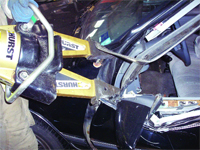 |
| Start by removing the trim around the door. |
Once we have placed the spreader in position (adjusting the angle of the tool’s base, slightly upward from horizontal so that the door is pulled outward, away from the patient), we can slowly open the tool sufficiently until the latch releases from the Nader bolt. By wrapping the door first with a looped strap, we can secure the door, preventing the door from releasing quickly. Again, we can thereby maintain safety for rescuers as well as patient(s).
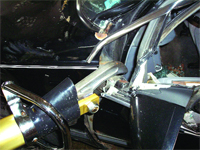 |
| Cutting the front door hinge. |
Removing a patient from the damaged side of the vehicle may create less stress and anxiety for the patient.
With many hands, firefighters can assist in patient packaging and removal.
Teamwork and good communication are always the key issues in a safe and speedy rescue.
Pete Methner is a firefighter in Niagara Falls, past education chairman for the Transportation Emergency Rescue Committee for Canada and the president of ON SCENE Rescue Training. He has competed both regionally and internationally and has taught firefighters from around the world. Contact Pete at autoexed@cogeco.ca .
April 28, 2008
By Pete Methner
Print this page
Advertisement
Stories continue below
Related
- Incident Report: Barn structure posed challenges
- Nuclear management: Unique Point Lepreau ICS combines plant personnel; local, regional departments